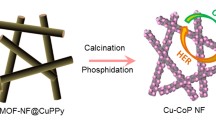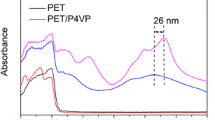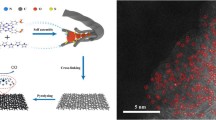Abstract
The need for develo** a decyanidating agent has been inspired by the extreme toxicity of cyanide which could lead to serious health challenges. Herein, the diazotization-esterification mechanism was employed to synthesize 1-(2-pyridylazo)-2-naphthyl-bis(ƞ5-cyclopentadienyl)iron carboxylate, FePNCp, which was further embedded on synthesized electrospun polyvinyl-benzyl chloride (ePVBC) to form a functionalized nanofiber composite material of poly(ferrocenyl-l-(2-pyridylazo)-2-naphthylvinylbenzylchloride, (FePNCp-PVBC). The morphology of the functionalized nanofiber showed a smooth fibrous and porous assembled structure with an average particle size of 19.92 nm. However, due to the intrinsic properties of the newly produced material, it was applied in the entrap** of cyanide ions from an aqueous medium. With a sorbent dosage of 0.01 g in 8 mg/L CN− concentration, 92.2% decyanidation capacity was obtained within 45 min for FePNCp-PVBC while 65.83% was obtained for the unfunctionalized ePVBC. The obvious improvement recorded by FePNCp-PVBC for the entrapment of CN− ions could be attributed to the coordinative interaction between the ferrocenyl molecule and the cyanide ligand. By comparing with similar nanofiber materials, this new FePNCp-PVBC gave higher performance efficiency and thus could serve as a better alternative to cyanide detoxification.









Similar content being viewed by others
Data Availability
The data that support the findings of this study are available from the corresponding author upon reasonable request.
References
Alfonso M, Tárraga A, Molina P (2010) Ferrocene-based multichannel molecular chemosensors with high selectivity and sensitivity for pb(ii) and hg(ii) metal cations. Dalt Trans 39:8637–8645. https://doi.org/10.1039/c0dt00450b
An M, Kim S, Hong JD (2010) Synthesis and characterization of peripherally ferrocene-modified zinc phthalocyanine for dye-sensitized solar cell. Bull Korean Chem Soc 31:3272–3278. https://doi.org/10.5012/bkcs.2010.31.11.3272
Astruc D (2017) Why is ferrocene so exceptional? Eur J Inorg Chem 2017:6–29. https://doi.org/10.1002/ejic.201600983
Abou-Dobara MI, Omar NF, Diab MA et al (2019) Allyl rhodanine azo dye derivatives: potential antimicrobials target d-alanyl carrier protein ligase and nucleoside diphosphate kinase. J Cell Biochem 120:1667–1678. https://doi.org/10.1002/jcb.27473
El-Sonbati AZ, Diab MA, Morgan SM et al (2020) Synthesis, characterization, theoretical and molecular docking studies of mixed-ligand complexes of Cu(II), ni(II), Co(II), mn(II), cr(III), UO2(II) and cd(II). J Mol Struct 1200:127065. https://doi.org/10.1016/j.molstruc.2019.127065
Yang X, Liu H (2019) Diphenylphosphine-substituted ferrocene/silsesquioxane-based hybrid porous polymers as highly efficient adsorbents for water treatment. ACS Appl Mater Interfaces 11:26474–26482. https://doi.org/10.1021/acsami.9b07874
Zhou Y, Ma J, Gao C et al (2021) Electrospun nanofibers from ferrocene-containing multiblock copolymers prepared via RAFT polymerization with F127 modified precursor. J Appl Polym Sci 138:1–13. https://doi.org/10.1002/app.50984
Hosseinzadeh R, Maliji F, Golchoubian H, Bekhradnia A (2019) A novel ferrocene-based calix[4]arene as an efficient optical and electrochemical sensor for highly selective fluoride recognition. ChemistrySelect 4:3914–3920. https://doi.org/10.1002/slct.201900241
Floris B (2015) Ferrocene in agriculture: from agrochemicals and soil remediation to selective chemosensors. Chem Biol Technol Agric 2:1–14. https://doi.org/10.1186/s40538-015-0038-0
Rabti A, Hannachi A, Maghraoui-Meherzi H, Raouafi N (2019) Ferrocene–functionalized carbon nanotubes: an adsorbent for rhodamine B. Chem Afr 2:113–122. https://doi.org/10.1007/s42250-018-00031-0
Adewuyi S, Sanyaolu NO, Amolegbe SA et al (2012) Poly[β-(1→4)-2-amino-2-deoxy-D-ghicopyranose] based zero valent nickel nanocomposite for efficient reduction of nitrate in water. J Environ Sci. https://doi.org/10.1016/S1001-0742(11)60903-0
Geng TM, Fang XC, Wang FQ, Zhu F (2022) Azine- and azo-based flexible covalent organic frameworks for fluorescence sensing nitro-aromatic compounds and iodine and adsorbing iodine. React Funct Polym 176:105309. https://doi.org/10.1016/j.reactfunctpolym.2022.105309
Mathew ME, Ahmad I, Thomas S et al (2021) A preliminary study on the synthesis of poly(vinylbenzyl chloride) with different solvents. Sains Malaysiana 50:1767–1773. https://doi.org/10.17576/jsm-2021-5006-22
Kiliclar HC, Altinkok C, Yilmaz G, Yagci Y (2021) Visible light induced step-growth polymerization by electrophilic aromatic substitution reactions. Chem Commun 57:5398–5401. https://doi.org/10.1039/d1cc01444g
Huang Y, Han W, Ruan Y et al (2023) Highly efficient and easy separation of polysaccharide-based cyanide-bridged bimetallic coordination polymers for thallium removal: performance and mechanisms. J Environ Chem Eng. https://doi.org/10.1016/j.jece.2023.109786
Yubiao L, Kun C, Renjun Z (2021) Research progress on decyanation of cyanide tailings and recovery of valuable metal resources. Conserv Util Miner Resour 41:91–101. https://doi.org/10.13779/j.cnki.issn1001-0076.2021.01.014
Couture G, Améduri B (2012) Kinetics of RAFT homopolymerisation of vinylbenzyl chloride in the presence of xanthate or trithiocarbonate. Eur Polym J 48:1348–1356. https://doi.org/10.1016/j.eurpolymj.2012.03.020
Ogunlaja AS, Coombes MJ, Torto N, Tshentu ZR (2014) The adsorptive extraction of oxidized sulfur-containing compounds from fuels by using molecularly imprinted chitosan materials. React Funct Polym 81:61–76. https://doi.org/10.1016/j.reactfunctpolym.2014.04.006
Adewuyi S, Bisiriyu IO, Akinremi CA, Amolegbe SA (2017) Synthesis, spectroscopic, surface and catalytic reactivity of chitosan supported co(ii) and its zerovalentcobalt nanobiocomposite. J Inorg Organomet Polym Mater 27:114–121. https://doi.org/10.1007/s10904-016-0452-1
Nirwan VP, Pandey S, Hey-Hawkins E, Fahmi A (2020) Hybrid 2D nanofibers based on poly(ethylene oxide)/polystyrene matrix and poly(ferrocenylphosphinoboranes) as functional agents. J Appl Polym Sci 137:1–8. https://doi.org/10.1002/app.49091
Saim AK, Darteh FK, Cobbinah IJ et al (2023) Synthesis of ASB-CuO nanocomposite for efficient cyanide degradation from aqueous systems: fundamentals and potential applications to tailings water from gold operations. Hydrometallurgy 218:106059. https://doi.org/10.1016/j.hydromet.2023.106059
De Gisi S, Lofrano G, Grassi M, Notarnicola M (2016) Characteristics and adsorption capacities of low-cost sorbents for wastewater treatment: a review. Sustain Mater Technol 9:10–40. https://doi.org/10.1016/j.susmat.2016.06.002
Petrovic B, Gorbounov M, Masoudi Soltani S (2021) Influence of surface modification on selective CO2 adsorption: a technical review on mechanisms and methods. Microporous Mesoporous Mater 312:110751. https://doi.org/10.1016/j.micromeso.2020.110751
Osobamiro MT (2012) Determination of the concentration of total cyanide in waste water of a tobacco company in Southwestern Nigeria. J Appl Sci Environ Manag 16:61–63
Jaszczak E, Polkowska Ż, Narkowicz S, Namieśnik J (2017) Cyanides in the environment—analysis—problems and challenges. Environ Sci Pollut Res 24:15929–15948. https://doi.org/10.1007/s11356-017-9081-7
Farrokhi M, Yang JK, Lee SM, Shirzad-Siboni M (2013) Effect of organic matter on cyanide removal by illuminated titanium dioxide or zinc oxide nanoparticles. J Environ Heal Sci Eng 11:1. https://doi.org/10.1186/2052-336X-11-23
Wei P, Zhang Y, Huang Y, Chen L (2023) Structural design of SiO2/TiO2 materials and their adsorption-photocatalytic activities and mechanism of treating cyanide wastewater. J Mol Liq 377:121519. https://doi.org/10.1016/j.molliq.2023.121519
Bashir S, Hina M, Iqbal J et al (2020) Fundamental concepts of hydrogels: synthesis, properties, and their applications. Polym (Basel) 12:1–60. https://doi.org/10.3390/polym12112702
Adewuyi S, Jacob JM, Olaleye OO et al (2016) Chitosan-bound pyridinedicarboxylate ni(II) and Fe(III) complex biopolymer films as waste water decyanidation agents. Carbohydr Polym 151:1235–1239. https://doi.org/10.1016/j.carbpol.2016.06.070
Eke-emezie N, Etuk BR, Akpan OP, Chinweoke OC (2022) Cyanide removal from cassava wastewater onto H3PO4 activated periwinkle shell carbon. Appl Water Sci 12:1–12. https://doi.org/10.1007/s13201-022-01679-3
Martin N, Ya V, Naddeo V et al (2021) Cyanide removal and recovery by electrochemical crystallization process. Water (Switzerland) 13:1–15. https://doi.org/10.3390/w13192704
Wagholikar S, Patil Y (2022) Eliminating cyanide species from aqueous matrices: an overview on some physical-chemical and nano-based techniques. 2022 Int conf interdiscip res technol manag IRTM 2022 - Proc. https://doi.org/10.1109/IRTM54583.2022.9791810
Ghosh S, Gulhane A, Sharma P et al (2023) Quantitation of free cyanide using ion exchange chromatography in Neisseria meningitidis serogroups a, C, W, Y and X conjugates used in vaccine manufacture. Biologicals 81:101664. https://doi.org/10.1016/j.biologicals.2023.101664
Shahedi A, Darban AK, Jamshidi-Zanjani A et al (2023) Simultaneous removal of cyanide and heavy metals using photoelectrocoagulation. Water. https://doi.org/10.3390/w15030581
Khota W, Kaewpila C, Suwannasing R et al (2023) Ensiling cyanide residue and in vitro rumen fermentation of cassava root silage treated with cyanide-utilizing bacteria and cellulase. Fermentation 9:1–13. https://doi.org/10.3390/fermentation9020151
Hayati M (2021) A fuzzy MADM Approach for selecting the best cyanide removal method from a gold mine wastewater. Res Sq Prepr. https://doi.org/10.21203/rs.3.rs-821222/v1
Amaouche H, Chergui S, Halet F et al (2019) Removal of cyanide in aqueous solution by oxidation with hydrogen peroxide catalyzed by copper oxide. Water Sci Technol 80:126–133. https://doi.org/10.2166/wst.2019.254
Ejeromedoghene O, Adewuyi S, Amolegbe SA et al (2018) Electrovalent chitosan functionalized methyl-orange/metal nanocomposites as chemosensors for toxic aqueous anions. Nano-Struct Nano-Objects. https://doi.org/10.1016/j.nanoso.2018.06.004
Jordan A, Whymark KD, Sydenham J, Sneddon HF (2021) A solvent-reagent selection guide for Steglich-type esterification of carboxylic acids. Green Chem 23:6405–6413. https://doi.org/10.1039/d1gc02251b
Xu F, Li H, Luo YL, Tang W (2017) Redox-responsive self-assembly micelles from poly(n-acryloylmorpholine-block-2-acryloyloxyethyl ferrocenecarboxylate) amphiphilic block copolymers as drug release carriers. ACS Appl Mater Interfaces 9:5181–5192. https://doi.org/10.1021/acsami.6b16017
Mihaescu IM, Drochioiu G (2009) Cyanide reaction with ninhydrin: the effect of pH changes and UV-vis radiation upon the analytical results. Rev Roum Chim 54:841–845
Nhung LTT, Kim IY, Yoon YS (2020) Quaternized chitosan-based anion exchange membrane composited with quaternized poly(vinylbenzyl chloride)/polysulfone blend. Polym (Basel) 12:1–16. https://doi.org/10.3390/polym12112714
Peng R, Zhang W, Ran Q et al (2011) Magnetically switchable bioelectrocatalytic system based on ferrocene grafted iron oxide nanoparticles. Langmuir 27:2910–2916. https://doi.org/10.1021/la1040486
Vengatesan S, Santhi S, Sozhan G et al (2015) Novel cross-linked anion exchange membrane based on hexaminium functionalized poly(vinylbenzyl chloride). RSC Adv 5:27365–27371. https://doi.org/10.1039/c4ra16203j
Lee M, Chen BY, Den W (2015) Chitosan as a natural polymer for heterogeneous catalysts support: a short review on its applications. Appl Sci 5:1272–1283. https://doi.org/10.3390/app5041272
Locatelli C, Leal PC, Yunes RA et al (2009) Gallic acid ester derivatives induce apoptosis and cell adhesion inhibition in melanoma cells: the relationship between free radical generation, glutathione depletion and cell death. Chem Biol Interact 181:175–184. https://doi.org/10.1016/j.cbi.2009.06.019
Mudabuka B, Ogunlaja AS, Tshentu ZR, Torto N (2016) Electrospun poly(vinylbenzyl chloride) nanofibres functionalised with tris-(2,2′-pyridylimidazole)iron(III): a test strip for detection of ascorbic acid and dopamine. Sens Actuators B Chem 222:598–604. https://doi.org/10.1016/j.snb.2015.08.081
Kang D, Lee JS, Yoon HH et al (2022) Electrospun poly(styrene – Co – vinylbenzyl chloride – Co – acrylonitrile) nanofiber mat as an anion exchange membrane for fuel cell applications. Polym (Basel). https://doi.org/10.3390/polym14163236
Adeyemi D, Mokgadi J, Darkwa J et al (2011) Electrospun nanofibers sorbents for pre-concentration of 1,1-dichloro-2,2 bis-(4-chlorophenyl)ethylene with subsequent desorption by pressurized hot water extraction. Chromatographia 73:1015–1020. https://doi.org/10.1007/s10337-011-1989-3
Anan NA, Hassan SM, Saad EM et al (2011) Preparation, characterization and pH-metric measurements of 4-hydroxysalicylidenechitosan Schiff-base complexes of Fe(III), Co(II), ni(II), Cu(II), zn(II), Ru(III), rh(III), pd(II) and au(III). Carbohydr Res 346:775–793. https://doi.org/10.1016/j.carres.2011.01.014
Akinremi CA, Omosun NN, Adewuyi S et al (2016) Preparation and characterization of chitosan-humic acid-zerovalent iron nanocomposite for nitrate reduction in water. J Appl Chem 2016:1–8. https://doi.org/10.1155/2016/1895854
Liu X, Zhao X, xin, Liu Y, Zhang T, (2022) An review on preparationd adsorption properties of chitosand chitosan composites. Springer, Berlin, Heidelberg
Li Y, Zhang H, Jiang Y et al (2019) Assembly of metallophthalocyanine-polyoxometalate hybrid for highly efficient desulfurization of organic and inorganic sulfur under aerobic conditions. Fuel 241:861–869. https://doi.org/10.1016/j.fuel.2018.12.091
Olaoye R, Afolayan O, Mustapha O, Adeleke H (2018) The efficacy of banana peel activated carbon in the removal of cyanide and selected metals from Cassava processing wastewater. Adv Res 16:1–12. https://doi.org/10.9734/air/2018/43070
Rasoulzadeh H, Sheikhmohammadi A, Abtahi M et al (2021) Predicting the capability of diatomite magnano composite boosted with polymer extracted from brown seaweeds for the adsorption of cyanide from water solutions using the response surface methodology: modelling and optimisation. Int J Environ Anal Chem 00:1–14. https://doi.org/10.1080/03067319.2021.1931160
Ahmed EM, Alsanie F, Alhomrani W (2022) Cyanide removal from aqueous environment by resting cells and PTFE immobilized cells of Sphingobacterium spp. J Basic Microbiol 62:444–454. https://doi.org/10.1002/jobm.202100292
Author information
Authors and Affiliations
Corresponding author
Ethics declarations
Conflict of interest
The authors declare no conflict of interest.
Additional information
Publisher’s Note
Springer Nature remains neutral with regard to jurisdictional claims in published maps and institutional affiliations.
Rights and permissions
Springer Nature or its licensor (e.g. a society or other partner) holds exclusive rights to this article under a publishing agreement with the author(s) or other rightsholder(s); author self-archiving of the accepted manuscript version of this article is solely governed by the terms of such publishing agreement and applicable law.
About this article
Cite this article
Adesoji, A.O., Shotonwa, I.O., Ejeromedoghene, O. et al. Ester-Functionalized Ferrocene Based Polyvinylbenzyl Chloride Nanofiber as a Decyanidating Agent. Chemistry Africa 6, 2609–2619 (2023). https://doi.org/10.1007/s42250-023-00677-5
Received:
Accepted:
Published:
Issue Date:
DOI: https://doi.org/10.1007/s42250-023-00677-5




